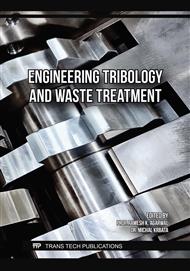p.19
p.33
p.43
p.61
p.71
p.77
p.83
p.89
p.97
Synthesis of Epoxidized Waste Cooking Oil as Plasticizer in the Production of Xyloglucan-Chitosan Films
Abstract:
The synthesis of epoxidized waste cooking oil (EWCO) from used oil and the potential of using EWCO as a plasticizer to replace glycerol in xyloglucan-chitosan film were studied. The epoxidation reaction generated an epoxy group, which was induced to break off and form OH groups, potentially used as EWCO plasticizers (EWCOP). The determination of EWCOP by analyzing the chemical structure using FT-IR, where peaks were observed at 3496 cm-1 and 827 cm-1, indicating the opening of the epoxy group. According to the physical properties test, EWCOP has a total acid number of 9.91 mg KOH/g, a flash point below 50 °C, and a viscosity of 0.79 cST at 40 °C. A xyloglucan-chitosan film was prepared using a concentration ratio of xyloglucan to chitosan of 4:1, mixed with a solution of glycerol and EWCOP as the plasticizer at ratios of 7:0, 5:2, 3:4, and 0:7, representing 35% of the total weight of solids. The tensile strength of the xyloglucan-chitosan film increases with a decrease in the glycerol : EWCOP ratio, offering hope for the potential of EWCOP in future applications. Conversely, an increase in the glycerol : EWCOP ratio reduces the elongation of the xyloglucan-chitosan film. The water vapor transfer rate and Tg in the xyloglucan-chitosan film are lowest when the glycerol : EWCOP ratio is 3:4 and 0:7, respectively. The results showed that using EWCOP as plasticizers to replace glycerol significantly enhanced many aspects of synthesized xyloglucan-chitosan film properties, demonstrating the potential of this research to make a substantial impact in the field.
Info:
Periodical:
Pages:
71-76
Citation:
Online since:
June 2025
Price:
Сopyright:
© 2025 Trans Tech Publications Ltd. All Rights Reserved
Share:
Citation:


